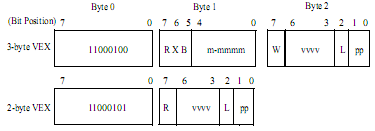In the last few week I’ve been working on diStorm to add the new instruction sets: AVX and FMA. You can find lots of information about them on the inet. In a brief, the big advantages, are support of 256 bit registers, called now YMM’s (their low halves are XMM’s) and also support for AES built in, you have a few instruction to do small block encryption and decryption, really sweet. I guess it will help some security companies out there to boost stuff. Also the main feature behind these instruction sets is the 3 registers operands. So now you are not stuck with 2 registers per instruction, you can have up to four sometimes. This is good because you have two source operands and a destination operand, which means it saves you other instructions (to move or backup registers) and you don’t have to ruin your dest-src operand like in the old sets. Almost forgot to mention FMA itself, which is fused multiply-add instructions, so you can do two operations at once, like A*B+C, etc.
I wanted to talk about the VEX prefix itself. It’s really a new design and approach to prefixes that was never seen before. And the title of this post says it all, it’s really annoying.
The VEX (Vector Extension) prefix, is a multi-byte prefix for a change. It can be either 2 or 3 bytes. If you take a look at the one byte opcodes map, all of them are taken. Intel was in the need of a new unused byte, which didn’t really exist. What they did instead, was to share two existing opcodes, for each prefix. The sharing works in a special way, that let them know if you meant to use the original instruction or the new prefix. The chosen instructions are LDS (0xc4) and LES (0xc5). When you examine the second byte of these instructions, the byte upon which the new information is extracted from, you can learn that the most significant two bits can’t be set together (I.E: the value of 0xc0 or higher). However, if they are set, the processor will raise an illegal instruction exception. This is where the VEX prefix enters into the game. Instead of raising an exception they will be decoded as this special multi-byte prefix. Note that in 64 bits mode, all those Load-Segment instruction are invalid, so there is no need for sharing the opcode. When you encounter 0xc4 or 0xc5, you know it’s a VEX prefix, as simple as that. Unfortunately this is not the case in 32 bits mode, and since the second byte has to be with a value higher than 0xc0 (because the two most significant bits have to be set in 32 bits), the field in these corresponding bits is inverted actually, which means you will have to extract a few bits that represent some fields and bitwise-not them. This is seriously gross, but it seems Intel didn’t have much of a choice here. If it were up to me, I would do the same eventually, for the sake of backward compatibility, but it doesn’t make it any prettier to be honest. And for your information, AMD pulled the same trick but with the POP instruction (0x8f) for their new instruction sets (XOP, etc), without full backward compatibility.
To make some order in the bits let’s have a look at the following figure:

Cited Intel
Well, I am not going to talk about all fields, (which somewhat are similar to REX for 64 bits) but just about one interesting feature. Since now the prefix is 2/3 bytes and usually an SSE instruction is at least 3 bytes, this will explode the code segment with huge instruction, and certainly gonna make the processor cry a lot to fetch instructions. The trick that was used by Intel (and AMD too) was to have a field that will imply which prefix byte to put virtually before the VEX prefix itself, so this way we saved one byte. And the same idea was used again to spare the 0x0f escape byte or even two bytes of 0x0f, 0x38 or 0x0f, 0x3a which are very common basic opcodes for SSE instructions. So if we had to use an SSE instruction, for instance:
66 0f 38 17 c0; PTEST XMM0, XMM0 – has first 3 bytes that can be implied in the VEX prefix, thus it stays the same size! Kawabanga
I talked in an earlier post that I am not going to support SSE5 as for now, in the hope it’s gonna die. I believe CPU (or instruction set architectures, to be accurate) wars are bad for the coders and even for end users who can’t really enjoy those great technologies eventually.
“I talked in an earlier post that I am not going to support SSE5 as for now, in the hope it’s gonna die. ”
In fact, AMD says that it is already dead in favor of the above-mentioned XOP instructions.
“This is seriously gross”
Not only that, but NTVDM uses the same previously illegal LES opcode with the second byte above 0xC0 as a trap in V86 mode, which means that in real/virtual 8086 modes the VEX prefix has to be disabled!
You are totally right. I forgot to mention BOP’s, good idea. In W7 there’s no NTVDM anymore AFAIK.
Also check this out:
http://www.ragestorm.net/tutorial?id=27
32-bit Windows 7 I think does still have NTVDM, but no 64-bit version of Windows have it. (Long mode do not support V86 mode at all.)